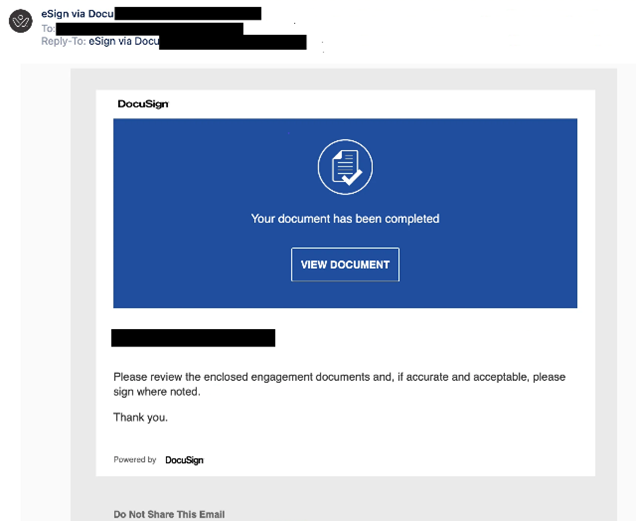In the world of online scams, phishing emails remain a prevalent threat, where scammers mimic trustworthy entities to steal your personal and financial data or login credentials. Docusign, a reputable leader in electronic signature technology, has unfortunately become a common disguise for such scams. Keep reading for all you need to know about how to recognise and protect yourself from Docusign scam emails.
How Docusign Phishing Emails Work and Risks
Docusign scam emails copy the appearance of legitimate Docusign emails to try to deceive you. Typically, they will prompt you to click a button to view or sign a document. This button redirects to a phishing site designed to steal your personal/financial information or login credentials. To make the bogus emails look authentic, scammers misuse the Docusign logo and copy the overall style of genuine Docusign emails. See below for two examples of Docusign scam emails.


If you were to be deceived by a Docusign scam email and enter your information on a fake, scammer-controlled website, you could face several significant risks. Scammers could use your personal data for identity theft, potentially causing long-term damage to your credit and personal reputation. Additionally, if you provide financial information, you could experience unauthorised charges or financial loss. Entering your login credentials on a fake site also risks giving scammers access to your accounts, which they can use for further malicious activities.
Common Docusign Scams
Docusign scams often involve requests to review a document or provide a signature without a specific reason. However, scammers also frequently embellish these emails with additional information to enhance their deception. Here are some examples:
- Job offers: Emails may claim to contain job offers or promotion contracts, exploiting excitement and urgency to view such documents.
- Legal notices: These scams send urgent legal notices or court-related documents, creating a sense of necessity and prompting quick action due to potential legal consequences.
- Tax documents: Around tax season, Docusign phishing emails might appear to include critical tax forms, leveraging the time sensitivity of tax filing deadlines.
The above examples are just a few of the tactics used by scammers, but be aware that they never stop devising new methods to deceive people.
Docusign Phishing Scam Red Flags
To protect yourself, watch out for these Docusign phishing email scam red flags:
- Unexpected requests: Be wary of unsolicited emails asking you to open a document or provide personal information, especially if you were not expecting to receive a document requiring a signature or you don’t recognise the sender.
- Incorrect email addresses: Check the sender’s email address. It should match the official Docusign domains, which are “docusign.com” or “docusign.net”.
- Generic greetings: Phishing emails will often address you in a generic manner such as “Dear User” or “Hello,” without using your actual name.
- Suspicious links and attachments: Avoid clicking on links or downloading attachments in unexpected emails. Hover over links to verify their destination.
- Urgency and threats: Phishing attempts often create a sense of urgency or use alarming language to provoke a quick response.
- Grammar and spelling errors: While not always present nowadays, poor grammar and spelling can still be a giveaway of a scam.
